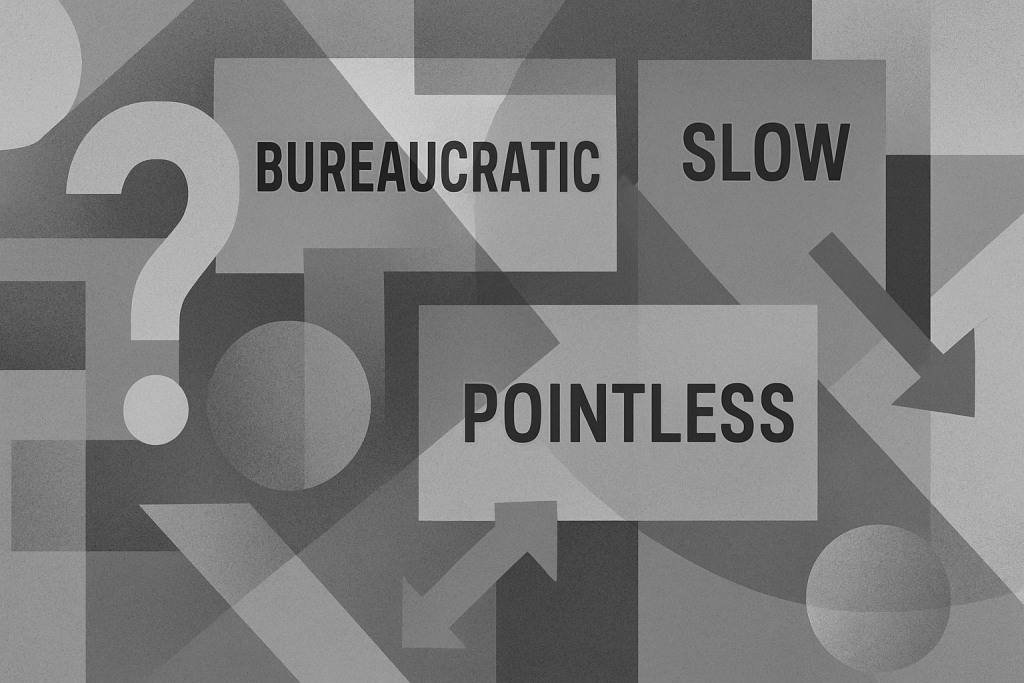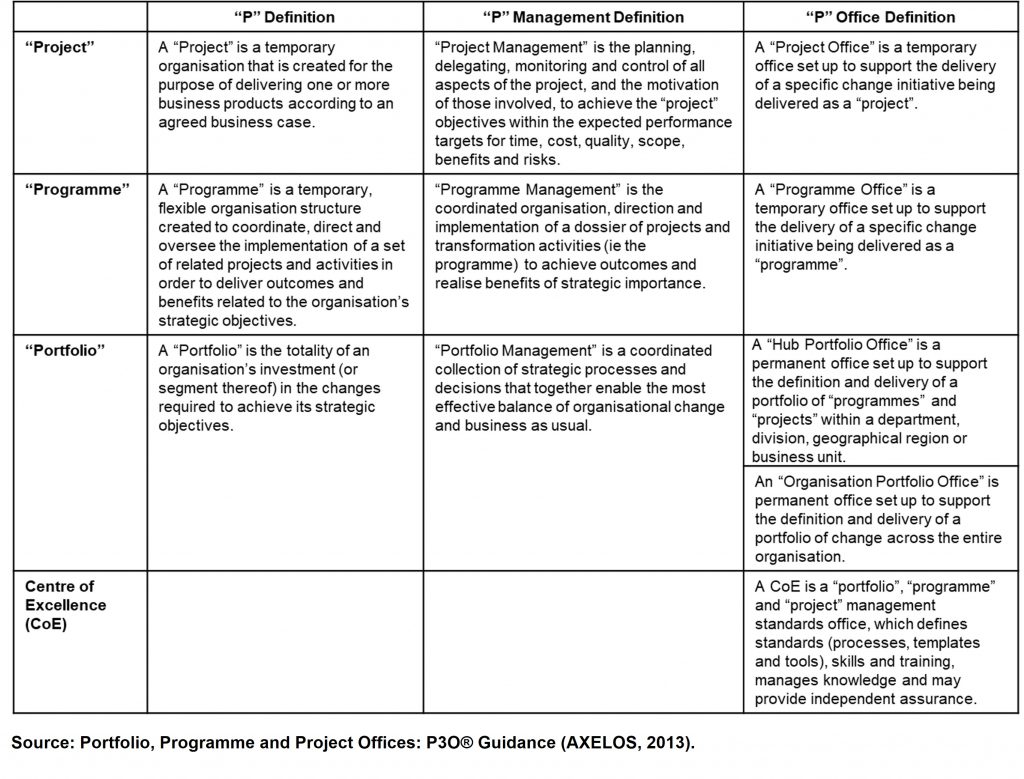
Definitions Of Organisational Change In The Public Sector And The Third Sector
If you spend time around change initiatives, you may hear comments about the PMO. Whether on LinkedIn or in office corridors, people sometimes express frustration, labelling PMOs as “bureaucratic,” “slow,” or even “pointless.” However, in theory, the PMO is designed to do the opposite: to help organisations implement initiatives more smoothly, consistently, and transparently.
So, why does the PMO often receive negative feedback? And what is an alternative?
Contents
So What Does The “P” In “PMO” Actually Mean?
One interpretation of what the “P” in “PMO” represents is P3O®. P3O® aims to assist organisations in establishing the necessary support structures for the successful delivery of their portfolios of change “programmes” and “projects”.
In practice, many organisations lack a clear hierarchy of structures and consistent naming conventions. Change initiatives are often simply referred to as “projects,” and the terms “projects” and “programmes” are used interchangeably without a clear rationale. In some cases, a so-called “portfolio” is treated as little more than a list of projects.
This inconsistency between projects and programmes leads to confusion in governance and management. When language is used inconsistently, executives, sponsors, change teams, and stakeholders may not have a shared understanding of scope, accountability, or outcomes. This can increase the risk of duplication, poor oversight, and missed benefits. Such confusion can also result in misunderstandings regarding the role of the organisation’s PMOs.
What Is Portfolio, Programme and Project Offices (P30®)
One of the significant contributions of the Office of Government Commerce was the development of the P3O® (Portfolio, Programme, and Project Offices) framework, first published in 2008.
While a PMO is typically understood as a “Project Management Office”, it may have been established to support a programme, a portfolio, or even a Centre of Excellence (CoE) in P3O terminology. However, the focus of such a PMO may be on cost, time, and quality rather than on the broader activities associated with an initiative.
Common Reasons For The Negative Perceptions Of PMOs
Some view a PMO as the “Project Police.” Rather than being seen as a supportive partner that helps teams succeed, it is often perceived as a group that enforces rules, demands excessive reporting, and hinders progress. For delivery teams working under pressure, the PMO can feel more like an obstacle than an ally.
Common reasons for the negative perception are:
Duumy
Lorem ipsum dolor sit amet, consectetur adipiscing elit. Ut elit tellus, luctus nec ullamcorper mattis, pulvinar dapibus leo.
Bureaucracy Over Value
PMOs can spend excessive time focusing on templates, forms, and checklists, leading people to forget their primary purpose — to facilitate smoother and more effective project delivery. When the emphasis on paperwork overshadows its value, frustration can quickly arise.
Misalignment With Strategy
If a PMO fails to demonstrate how projects align with the organisation’s broader strategy, it risks being perceived as merely an administrative function rather than a catalyst for results.
Inflexibility
A common pitfall for many PMOs is rigidity. They often stick to a single method, even when teams require more flexible approaches. This inflexibility can make the PMO seem disconnected from the needs of the organisation.
Poor Communication
PMOs frequently communicate primarily with leadership, neglecting to engage with the teams responsible for actual project delivery. This can create the impression that the PMO’s role is simply to generate reports for senior management, rather than to support teams in successfully completing their projects.
When a PMO is viewed negatively, it can have significant consequences. Teams may resist its involvement, and leaders might choose to bypass it when making decisions. As a result, the PMO may struggle to demonstrate its value and justify its budget. Over time, this situation can lead to increased staff turnover, and the PMO risks being quietly dismantled.
Flipping the Narrative
It doesn’t have to be this way. A well-functioning PMO can be a game-changer. Rather than merely enforcing rules, it can act as an enabler. Instead of overwhelming teams with reports, it can provide valuable insights that empower leaders and teams to make better decisions.
The most effective PMOs:
- Adapt their methods to align with the organisation’s culture;
- Clearly connect initiatives to strategic goals;
- Offer practical support and guidance that teams find useful;
- Build credibility by employing individuals who understand the delivery process;
- Communicate openly with both leadership and delivery teams.
These principles are central to the Project Management Institute’s comprehensive publication, “Project Management Offices: A Practice Guide“, released in 2025.
The practice guide provides definitions for a Portfolio Management Office and a Program(me) Management Office, but does not address how a Project Management Office interacts with these functions. In fact, the guide does not define what a project is. Instead, it categorises “PMO Services” into three groups: strategic, tactical, and operational. It then suggests how these categories can be applied across the domains of “portfolios”, “program(me)s”, and “projects”.
Although the practice guide does not explicitly define Organisational Change Management, it indicates in several places how a PMO can support organisational change. It also references the Project Management Institute’s sister publication, “Managing Change in Organizations: A Practice Guide”. In this guide, organisational change is defined as:
“A comprehensive, cyclic, and structured approach for transitioning individuals, groups, and organizations from a current state to a future state with intended business benefits. It helps organizations integrate and align people, processes, structures, culture, and strategy.”
This sister practice guide underscores that organisations can survive and thrive by adopting a disciplined approach to “portfolio”, “program(me)”, and “project” management, along with responsive, flexible, and effective change management within that context.
The Enterprise Change Office
The publication “Project Management Offices: A Practice Guide” does a commendable job of dispelling negative perceptions of what a PMO is and demonstrating how a well-tailored PMO can significantly add value to an organisation in effectively and efficiently executing its strategy. However, it seems that the publication has not reached as wide an audience as it deserves.
This blog, daschange.info, adopts a broad definition of organisational change and argues for a holistic and integrated approach to its management, facilitated by an overarching function. To emphasise this distinction, the blog refers to this function as an Enterprise Change Office.
This term highlights that the responsibilities of this function extend far beyond the mechanics of projects. It emphasises its role in supporting strategic change, making it clear that change involves much more than just plans and milestones; it also includes adoption, culture, and outcomes. Ultimately, the best label for this function is one that resonates with the specific organisation and effectively positions it as a crucial partner in transforming strategy into reality.

